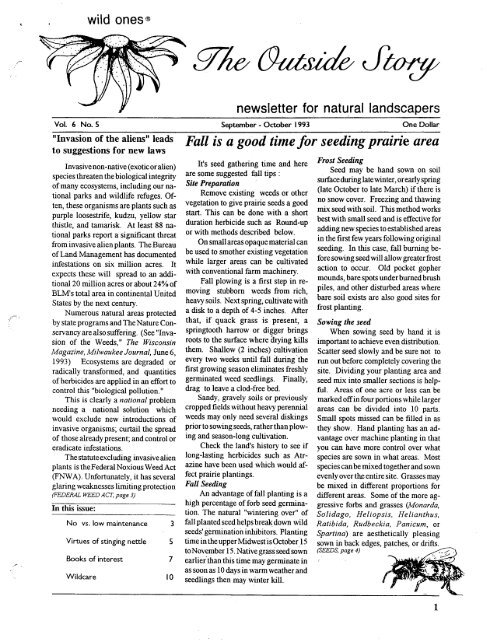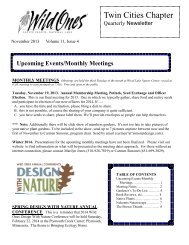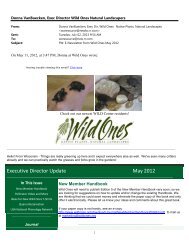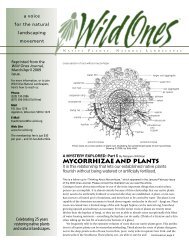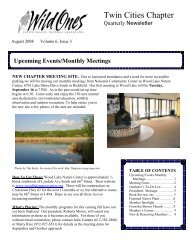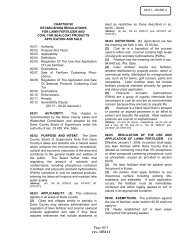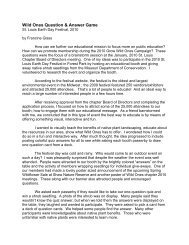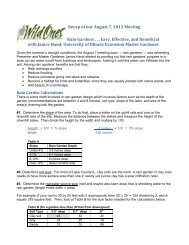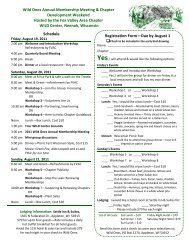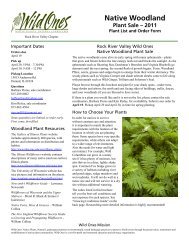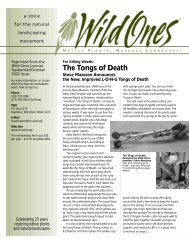Fall is a good time for seeding prairie area - Wild Ones
Fall is a good time for seeding prairie area - Wild Ones
Fall is a good time for seeding prairie area - Wild Ones
- No tags were found...
Create successful ePaper yourself
Turn your PDF publications into a flip-book with our unique Google optimized e-Paper software.
What <strong>is</strong> a weed really?What <strong>is</strong> a weed? There are almost asmany answers as there are weeds, but here <strong>area</strong> few <strong>for</strong> consideration:A weed <strong>is</strong> an ugly plant. (Beauty <strong>is</strong> in theeye of the beholder.)A weed <strong>is</strong> a vile, noxious plant that causesallergies (ragweed, po<strong>is</strong>on ivy), pain orscratches (nettles, berry briars, brambles, catbriar, roses, prickly ash), or impedes our travelthrough an <strong>area</strong> (tall grass, brambles, densethickets, tangling vines.)A weed <strong>is</strong> a plant that kills other plants byfeeding on them (m<strong>is</strong>tletoe, dodder), growingover them (wild grape, Virginia creeper, bittersweet),or harboring d<strong>is</strong>eases that infectother plants (gooseberry, juniper).A weed <strong>is</strong> a plant without commercialvalue.A weed <strong>is</strong> any plant growing where youdon't want it.A weed <strong>is</strong> a wild, uncultivated, or commonplant which grows allover the place.A weed <strong>is</strong> a plant you don't like or want..A weed <strong>is</strong> a plant which decreases theaesthetic or economic value of an <strong>area</strong>.Whether a plant <strong>is</strong> considered a weed.depends upon the situation and who <strong>is</strong> doingthejudging. Take, <strong>for</strong> example, the case of therare and endangered dwarf white lady slipper,Cypripedium candidum, growing in a justplowed and wet, limey, springy cornfield. Afarmer would, no doubt, consider tile orchid aweed to herbicide. <strong>Wild</strong>flower entilUsiastswould consider the corn to be the weed, andwant to protect the fen and delicate plant.A dictionary definition says a weed <strong>is</strong> "anintroduced plant growing in ground that <strong>is</strong> or(WEEDS. page 8)Couple gets media attention <strong>for</strong> second village mowing"Americans are so accustomed to pool-table lawns that a patch of nativevegetation can be a threat to the establ<strong>is</strong>hed order. In Germantown(W<strong>is</strong>consin), the powers-that-be sent out two police officers and a landscaperto mow down Curt<strong>is</strong> and Judy Crane's 20-by-120-foot strip of nativewildflowers and grasses.Germantown has got it backward. It's the obsession with the perfectlymanicured lawn that's the problem, not wildflowers. Deep-rooted andadapted to drought, most native species require little watering and nomowing; herbicides and fertilizer aren't needed, either. In a world offiniteresources, natural lawns ought to be encouraged, not stamped out. They canadd beauty and diversity to urban and suburban landscapes." (From theeditorial page of The Milwaukee Journal, Saturday, August 21, 1993.)The last newsletter described the Crane's year -long struggle with theirvillage over their native plants on typical subdiv<strong>is</strong>ion, difficult-tolandscapeberm. Neighbors in sympathy with their plight, have beendecorating lawns with pink flamingos and spinning plastic flowers andhandmade signs with statements such as "Germantown Approved Flowers,""Germantown Nature Zone," and "Landraped by Germantown."Community surveys needed <strong>for</strong> expanding data baseSurveys asking about village, city, school, and other public and privateinvolvement in natural landscaping are available from The Native PlantPreservation Coalition of the Milwaukee Audubon Society and <strong>Wild</strong> <strong>Ones</strong>.In<strong>for</strong>mation collected will be used to <strong>for</strong>m a clearer picture of current lawsand practices throughout W<strong>is</strong>consin. If you can fill out a <strong>for</strong>m <strong>for</strong> yourcommunity, please send a request and a self-addressed, stamped envelopeto: Rae Sweet, 8635 North Fielding Road, Milwaukee, WI 53217.Coalition plans February workshop <strong>for</strong> municipal officialsAttorney BretRappaportwilI speak ata seminar <strong>for</strong> community leadersconcerned with weed ordinances. H<strong>is</strong> topic will be "Lawn Ordinances:Case Studies, Legalities, and Suggested Guidelines <strong>for</strong> Avoiding Problems".Rappaport <strong>is</strong> author of a law journal article on the subject. Therewill also expert presentations on a number of other related topics. Pleasecall 414/351-2291, if you know of an official who should receive aninvitation. Space <strong>is</strong> limited <strong>for</strong> the event which <strong>is</strong> planned <strong>for</strong> Friday,February 1I, 1994, preceeding the UWM Natural Landscaping Seminar.Prairie Moon NurseryRoute 3 Box 163Wlnons. MN 55987(507) 452-1362l1JBayside Garden CenterComplete Garden Needs414-352-6159Native Plants and Seeds .Wetland. Prairie. WoodJand400 E. Brown Deer Rd.Milwaukee. WI 53217We have your native plants.2
(SEEDS, from page 1)All hand <strong>seeding</strong> should be followedby a light raking.If using a mechanical seeder, depthshould not be set more than 114inch <strong>for</strong><strong>for</strong>bs or 112inch <strong>for</strong> most grasses. F01-lowing <strong>seeding</strong> use a tractor or truck topull a farm drag with teeth adjusted tocut into soil about 2 inches or a use asquare piece of chain linkfence weighteddown with several cement blocks torake in seeds.Cover CropsCover crops of oats or winter wheatcan be used if the site <strong>is</strong> subject toerosion. A heavy cover crop can beplanted alone be<strong>for</strong>e natives are seededor it can be used to hold soil whileslower natives are taking root. Sincenative seedlings are difficult to identifythe first growing season, a cover crop(which <strong>is</strong> easily identified) <strong>is</strong> a <strong>good</strong>"security blanket." If the cover crop hasgerminated and <strong>is</strong> growing well, nativeseeds should also be doing well, even ifyou can't see them. M<strong>is</strong>sing cover cropshows <strong>area</strong>s needing re<strong>seeding</strong>.Other planting tipsA native <strong>prairie</strong> <strong>is</strong> a complex naturalecosystem. Attempting to duplicateth<strong>is</strong> environment which has evolvedover tens of thousands of years <strong>is</strong> difficult,if not impossible. But by usingcare and with nature as a model, abeautiful, natural-looking landscape canbe created.When planting a <strong>prairie</strong> from seed,patience, and dedication can't be overemphasizedbecause plantings may tendto look like a weed patch <strong>for</strong> a few years.. <strong>Fall</strong> and frost plantings don't needseed bed packing or watering as snowand rain firm the soil and provide mo<strong>is</strong>turebe<strong>for</strong>e seed germination begins.We thank Alan Wade of Winona, MiIUlesota <strong>for</strong>allowing us to use in<strong>for</strong>mation from h<strong>is</strong> native plantnursery catalog <strong>for</strong> the above article.• /1"1/;,iBaysl-de SCh 00I recIalms - natura I <strong>area</strong>';i' .flt; -Two new outdoor classrooms havebeen added to Bayside School's crabapplemeadow. Richard Butt, scienceteacher at the middle school has planteda <strong>prairie</strong> and Lorrie Otto has designedand contributed a woodland. Butt hasinvolved h<strong>is</strong> students in digging andtransplanting indicator specimens suchas silphiums, helianthus; rattlesnakemaster, stiff goldenrod, and spiderwort.A burr oak tree was added to give theeffect of an oak savannah.The W<strong>is</strong>consin Department ofNaturalResources contributed <strong>prairie</strong> grassGroup consulting offeredCRM' Ecosystems has workshopsavailable covering the seasonal topicsof site preparation and identification ofwarm season grasses and fall flowers.Limited class size will give participantsas much individualized attentionand outdoor "hands on" plant experienceas possible. Sessions will runapproximately two hours and will beheld at Prairie Ridge Nursery in Mt.Horeb, W<strong>is</strong>consin."Site Preparation" will be heldAugust 28 from 1O a.m. lo noon. "Identificationof Warm Season Grasses and<strong>Fall</strong> Flowers" will follow on September25. Cost <strong>is</strong> $20 per session. Call 608/437-5245 <strong>for</strong> more in<strong>for</strong>mation.Crops hurt as bees d<strong>is</strong>appearAccording to an article in ChicagoTribune, wild bees have almost van<strong>is</strong>hedin many urban <strong>area</strong>s. They havebecome victims of suburbanites whodestroy hives, plant bluegrass wherewildflowers once grew, and douse theiryards with insecticides.Farmers who need bees to pollinateapple and other crops, have also foundthat bees are being destroyed by parasiticmites. Scient<strong>is</strong>t are consideringaltering bee genes as a solution.seeds which were scattered among thetransplants in early June.The young woodland has an assortedcollection of native trees foundin stories, songs, and literature <strong>for</strong> gradeschool students: an Amercian chestnut,an American beech, a linden, ashagbark hickory, a yellow bud hickory,an ironwood, a musclewood, a blueash, hackberry, a chinkapin oak (cut inhalf by a resident rabbit), and a Europeanmulberry (from the childrens'song). As shade developes appropriate.flowers will be added, but until then oakand beech leaves are being used asground cover.Bayside School's natural <strong>area</strong> hasnow doubled since it was l<strong>is</strong>ted in CariTaylor-Carlson's Milwaukee Walks.. ,,,. . ",.'.Country Wt,t(arufs9(prsuy & .....Consu[ti"/JLta..'.(f Wetland. woodland and<strong>prairie</strong> restoration,"installation, management.and enhancement ' '.'.•.g. Prov<strong>is</strong>ion of native seed:'..and plant l11aterials
STINGING NElTLE(Urtica dioica)Nettle FamilyThe Inside Story.~ Other Names: Stingers, Greater Nettle,Common Nettle, Net Plant.Habitat: Damp, nutrient-rich soil,waste places, and roadsides.Description: Stinging Nettle <strong>is</strong> coveredwith br<strong>is</strong>tly, stinging hairs. Ithas a four-angled stem and slender,branching, feathery clusters of tinygreen<strong>is</strong>h-white flowers in the leafaxils. The leaves are 2 to 4 in. long,opposite, ovate, with heart-shapedbases, and are coarsely toothed.Height: 2-4 ft. Flowering: June-Sept.Comments: Th<strong>is</strong> plant <strong>is</strong> naturalized fromEurope. Since it <strong>is</strong> not a native species, it<strong>is</strong> considered a weed and a nu<strong>is</strong>ance. WhenI fin<strong>is</strong>h revealing all its attributes, maybe youwill change your mind.If added to a compost pile, it <strong>is</strong> said to speedthe decay process. A concoction of the rootsand leaves makes a natural pesticide againstaphids and flea beetles. At one <strong>time</strong> a linenlikefabric was made from th<strong>is</strong> plant, as wellas ropes and f<strong>is</strong>hing nets. It makes a <strong>good</strong>scalp conditioner, leaving the hair soft andglossy besides stimulating hair growth.When dried, the plant looses its sting andcontains 40% protein, rivaling cottonseedmeal as a source of the vital nutrient. Nettlefodder <strong>is</strong> said to make cows give more milk,and, if powdered and added to their feed, induceschickens to lay more eggs.Medicinal Use: A solution made from .theplant was used on burns, nosebleeds, and tohalt hemorrhage internally and externally.Doctors during the Civil War recorded howthey deliberately cut open and laid bare amajor artery of an adult sheep. They thensoaked a gauzelike material in a strong coldtea made of Stinging Nettle and applied itdirectly to the open wound. The bleedingstopped within a matter of minutes. Thenthey went a step further. They put someblood in the palms of their hands and addeda few drops of Nettle juice. Immediatelythe blood started to coagulate. In Englandthe plant <strong>is</strong> an accepted wash <strong>for</strong> "greenwounds, old rotten or stinking sores and gangrene."It has been suggested that Nettle bestudied further <strong>for</strong> possible usesagainst kidney and urinary systemailments. Recently, Germans havebeen using the root in treatment <strong>for</strong>. ,_
(WEEDS. from page 2)has been cultivated usually to the detrimentof crops or d<strong>is</strong>figurement of theplace--economically useless plants--plants with an unsightly appearance--plants that tend to grow freely andexclude or retard more valuable plants--plants with exuberant growth and injuriouseffects--a <strong>for</strong>b in rangeland."There's a lot of truth in that. Noticehow the definition places weeds in thecontext of cultivated ground and mentionsthat they are introduced. It <strong>is</strong> afact that most "real" weeds are notnative or evolved in our country. Theyare aliens or immigrants which werebrought from Europe and Asia. Althougha few were deliberately introduced,most came accidently, and manyin spite of ef<strong>for</strong>ts to keep them out.Native American communities ofwild plants like <strong>prairie</strong>s, woodlands,wetlands, and tundras are largely weedfreeexcept to the extent that they havebeen d<strong>is</strong>turbed. That <strong>is</strong>, the more theyhave been abused and d<strong>is</strong>turbed, themore weedy they are. Th<strong>is</strong> view of theworld of weeds sort of says that alloriginal, native vegetion <strong>is</strong> natural, andweeds are <strong>for</strong>eigners, the aliens, - likestarlings, house sparrows, Norway rats."Detriment, d<strong>is</strong>figurement, economicallyuseless, unsightly, exclusive,injurious" are all words relating to theopposition of economic endeavors suchas farming, ranching, developing, urbanizing(things that use our environment<strong>for</strong> the sole purpose of making usmoney). Th<strong>is</strong> part of the definitionimplies that all of nature <strong>is</strong> weeds. Thewhole earth <strong>is</strong> filled with them, tryingto res<strong>is</strong>t and fight back against all the"progress of man." What all th<strong>is</strong> means<strong>is</strong> that be<strong>for</strong>e there were people, therewere no weeds. Weeds come fromman's viewpoint not nature's.The Bible says weeds are a curse.They were not part of God's originalcreation which He called <strong>good</strong>. Weedscame as a part of the fall of man from thepr<strong>is</strong>tine condition of caretaker and gardenenjoyer to farmer and laborer. Nowhe must work by the sweat of h<strong>is</strong> browto eat and "Cursed <strong>is</strong> the ground <strong>for</strong> thythy sake; in sorrow shalt thou eat of it allthe days of thy life; thorns also andth<strong>is</strong>tles shall it bring <strong>for</strong>th to thee; andthou shalt eat the herb of the field."Genes<strong>is</strong> 3:17-18.H<strong>is</strong>tory supports th<strong>is</strong> view. "True"weeds evolved with man and h<strong>is</strong>agricultural and soil-d<strong>is</strong>turbanceactivities. They followed him from thecradle of civilization and spread withhim as he covered the earth. Hunters,gatherers, and primitive farmerspunching holes <strong>for</strong> a few corn kernelshad no weeds to contend with. Plowersand tillers, earth movers, and moundbuilders had weeds allover the place.Originally the land was coveredwith native plants specifically adaptedto conditions oftheir environment. Theycompeted <strong>for</strong> necessities which were inlirnitedsupply, like sunlight in the <strong>for</strong>estor water in the desert. They evolved byworking out methods best suited totheir needs.In every ecosystem there were a fewplants unsuited to compete with theconvergently-evolved masses. Instead. they chose a line of evolution whichhelped them gain ajump on everybodyelse by getting there first with the most.In floodplains, on wind blowouts, newlyturned up mounds, or hollows wheretrees fell over, after landslides, floods,or fires, in buffalo wallows, on gophermounds, there were always a few speciesthat couldjump in and grow right away.They had evolved more rapid means ofreproducing and growing in order totake advantage of these less-frequentlyoccurring d<strong>is</strong>turbances.For the most part these earlysuccessional plants were annuals whoseshort life cycle allowed them to evolverapidly .. They were fast growers andprolific seeders whose seeds oftenremained dormant, though viable, <strong>for</strong>hundreds of years, waiting <strong>for</strong>ad<strong>is</strong>turbance to trigger their germination.Many were sensitive to a quick flash oflight (hence the old farmer'stale aboutplowing during the dark of the moon).They were "pioneer" or "bandaid" plantsthat came in to cover bare soil or breaksin plant cover.In the United States, ragweed <strong>is</strong>such a plant. There are several species,each adapted to slightly different <strong>for</strong>msof d<strong>is</strong>turbance. On mo<strong>is</strong>t floodplains,giant ragweed would cover new soil,helping to prevent erosion, while slower,long-lived perennials began to grow. Inb<strong>is</strong>on wallows, other smaller ragweeddid the same thing. After a <strong>for</strong>est fire,fireweed, quaking aspen, and certainspecies of pines would begin to growthat first year. These are all opportun<strong>is</strong>ticplants capable of taking advantage ifgiven a chance.In nature, d<strong>is</strong>turbances are usuallysmall if they are frequent. Larger, morecatastrophic d<strong>is</strong>turbances, like theYellowstone fire of 1988, occur onlyevery century or so; there<strong>for</strong>e, evolutionin natural settings <strong>is</strong> relativelyslow. Giving these types of plants a(WEEDs. page 10)SEEDS & PLANTS<strong>for</strong>WETLANDS, WOODLANDS& PRAIRIES9738 Overland RoadMI'. Horeb, WI 53572608/437-52458
Natures Best ToYouGrowers of a Unique Selection of Native Plants- Locally collected seeds -Nursery propagated. not collected from the wild!- Quality balled and burlapped plants -Locally grownNative W<strong>is</strong>consin Plants Available <strong>for</strong> Purchase~:Freeman MapleRedMaple- sSilver MapleSugar MapleBlack Maple - pAllegany Serviceberry - pYellow Birch - sPaper BirchRiver BirchMusclewood - pBitternut Hickory - p, sShagbark Hickory - PCommon Hackberry - pPagoda DogwoodDowny HawthornDotted HawthornWhite AshBlack AshGreen AshBlue Ash- pThornless Common HoneylocustKentucky Coffeetree - sButternutBlack WalnutIronwood-pQuaking AspenBlack Cherry - sChokecherry - sWaf~WhiteOak-sSwamp White Oak - sBur OakRedOak-sAmerican LindenSbI:uhs:Running Serviceberry - sBlack Chockberry - PSilky DogwoodGray DogwoodRedosier DogwoodAmerican FilbertDwarf BushhoneysuckleEastern WahooCommon Witchhazel - pKalm St. JohnswortCommon WinterberryCommon NinebarkPotentillaAmerican PlumFragrant SumacStaghorn SumacPrairie RosePussy WillowAmerican EiderCommon SnowberryIndiancurrent Coralberry - sWitherod Viburnum - pNannyberry Viburnum - pBlackhaw Viburnum - PAm. Cranberrybush Viburnum- PEyer~s:BalsamFtrOldfield Common Juniper - pCreeping JuniperEastern RedcedarWhite SpruceWhite PineAmerican ArborvitaeCanada Hemlockp - Also available in small pottedplants from our Propagation Dept.upon request.s - Not currently available th<strong>is</strong>season, must be ordered prior toApril 1 to be assured a spring dugplant.W.180 N.6275 Marcy Road, Menomonee <strong>Fall</strong>s, WI 53051 (414)252-4988(Just North of Silver Spring on Marcy Road)
(WEEDS, from page 8)chance to hasten their evolution throughone human-eaused d<strong>is</strong>turbance afteranother, turned them into the aggressiveweeds we have today. Th<strong>is</strong> happenedin Asia and Europe where farmingmethods were evolving and improving.For thousands of years, humans,agriculture, and weeds grew together.In fact, some weeds are so likethe crops they grow beside that theirseeds cannot be separated by size, shape,weight, or <strong>time</strong> of maturation. Fewnative American weed species are problemsto the gardener or farmer; theyhave just not had sufficient <strong>time</strong> toevolve as the old world weeds have.Some wonderful adaptations thatweeds have come up with include makingmultitudes of seeds, having seedslive <strong>for</strong> centuries be<strong>for</strong>e germinating,having high germination rates, growingrapidly to overtop competing vegetation,or spreading flat to preventgrowth of other plants, having ex1remelyefficient methods of spreading seeds,and even having the ability to produceseed without pollination or fertilization.Just think how all cut off dandelionflowers tum to seeds on your lawnafter you mow. Many weeds alsospread by stollens or rhizomes, so cuttingor chopping these parts only servesto make more of them. It seems withweeds, you just can't win!Not only are they pers<strong>is</strong>tent, theyare omnipresent. Where ever peoplego, they follow. You want to findweeds, where do you go? Outtoavirgin<strong>prairie</strong> or bog? Of course not! You goto a farmer's field, your garden or lawn,the very place where you are trying thehardest to get rid of them. That's whereyou'll find them, busily adapting to anew hoe or herbicide, going about theirburgeoning way evolving new strategiesto cope with our new ways of tryingto eliminate them. If we ever do set uphousekeeping on the Moon or Mars,you can bet, the first plant to grow willbe a weed! - Pat ArmstrongPat' native landscaping <strong>is</strong> featured in theSeptember 1993 <strong>is</strong>sue of Country living.<strong>Wild</strong>care •.•September: F ALL TRANS-PLANTING <strong>is</strong> best <strong>for</strong> trillium, mayapple,shooting star, etc. For others,fall may be preferable because of lessweed competition, cooler temperatures,and more rain. Consult Rock's PrairiePropagation Handbook & Sperka'sGrowing <strong>Wild</strong>jlowers<strong>for</strong>tips. If you'veexpanded a woodland th<strong>is</strong> year, addappropriate groundlayer species now.UPDATE your yard's plant-eommunityrecords be<strong>for</strong>e leaves fall. Noteyoung plants' progress, and determinecounter -measures <strong>for</strong> aggressives ones.MARKfems & others known to emergelate in spring.ELEMENTARY SCHOOLS don'tall have natural <strong>area</strong>s ...yet. Your naturalyard could set the scene <strong>for</strong> an art orscience lesson--maybe start somethoughts to start a school <strong>prairie</strong>.BIRD-DOG ragweed locations. Assummer progressed, mowed-off ragweedplants <strong>for</strong>med flowers &seedheads close to the ground. Gravelshoulders between pavement & traditionallawns are a prime spot <strong>for</strong> th<strong>is</strong>determined-to-survive hayfever agent.SEED-COLLECTING DATES: SeeThe Outside Story, (Sept - Oct 1992)October: EXTEND the beauty. ofyour native yard by collecting & dryingstalks <strong>for</strong> winter enjoyment. JaneEmbertson's 1979 book, Pods: <strong>Wild</strong>flowersand Weeds in Their FinalBeauty, 'gives collecting <strong>time</strong>s & techniques.Colleen Weiler, who did manyof the arrangements in its color photos,gives workshop classes in our <strong>area</strong>."BUT OUR KIDS NEED ALAWN" ... Have you worked out anyprov<strong>is</strong>ions <strong>for</strong> play and sports in your<strong>prairie</strong>/woodland? Can you relocateany <strong>prairie</strong> paths? Cross & reconnectthem--kids love mazes. Is there spacein a clearing <strong>for</strong> fr<strong>is</strong>bee and hacky sack?Develop your own version of <strong>prairie</strong>croquet or bocce ball. What about anexerc<strong>is</strong>e path through the woods?QUESTION: "Condo" conjures imagesof chemically-eontrolled lawns andclipped shrubs. Do you know any naturallylandscaped ones? Just curious ...l~A:~~Grny-he.o.de.cl CeV'e~~ C/O~.WILDERNESS UNIVERSITY, afree Wednesday evening series, startsSeptember 15 at UW-Waukesha. DanBoehlke's woodland program <strong>is</strong> thegrand finale. Call 521-5445 <strong>for</strong> details."DO NOT BUY any cultivar ofloosestrife (Lythrum salicaria). Nomatter what nurserymen claim, evenloosestrife said to be sterile will crosswith that growing in the wild and producean invasive hybrid. Loosestrife,an exotic, destroys wetlands and has novalue to wildlife." - Faith Campbell,Natural Resources Defense CouncilA BIG THANKS to the DNR'sMichelle Anderson, Judy Crane whokept us on track, and all who helpedwith the State Fair project--wasn't it allworth it? Liatr<strong>is</strong> planted few years agobloomed and complemented newlyadded cup~plant and purple coneflowers.Great interest in our plants andAldo Leopold bench. We'll run thenewly rev<strong>is</strong>ed plans. - Barb GlasselNursery Grown <strong>Wild</strong>flowers-Native midwestern plants ofwoodlands, <strong>prairie</strong>s and wetlands~Perennials, shrubs and vines-Books on naturallandscapingFor a catalog please send 50 centsand your name and address to:Little Valley FannDept. WORoute 3 Box 544Spring Green, WI. 53588 _ 9fm//_ dl '""\~\~ . -p-----..:i;''Vf~'0,'., ~'"--d'/i~ ~;:.. ..: i.'J10
<strong>Wild</strong> <strong>Ones</strong> - Natural Landscapers, Ltd.President Irena Macek 414/242-7769Vice President/MembershipMandy Ploch 414/242-2723Secretary Jan Koel 414/251-7175TreasurerDorothy Boyer 414/375-3913Program Lorrie Otto 414/352-0734HospitalityBarb Glassel 414/354-8018D<strong>is</strong>play Leslie Grove 414/351-3239Newsletter EditorCarol Chew 414/351-0644Green Bay Chapter Contact:Jim Jerzak 414/499-5944Mad<strong>is</strong>on Chapter Contact:Dave Egan 608/262-9591Northern Illino<strong>is</strong> Chapter Contact:Pat Armstrong 708/983-8404Wehr Chapter Contact:Pat Brust414/529-4101<strong>Wild</strong> <strong>Ones</strong> - Natural Landscapers, Ltd. <strong>is</strong>a non-prof1i organization with a m<strong>is</strong>siollto educate and share in<strong>for</strong>mation withmembers and community at the ''plantsrootsII level and to promote bio-diversityand environmentally sound practices. Weare a diverse membership interested innatural landscaping using native speciesin developing plant communities.The Outside Story <strong>is</strong> publ<strong>is</strong>hed bimonthlyby <strong>Wild</strong> <strong>Ones</strong> - Natural Landscapers,Ltd.@Material <strong>for</strong> newsletters <strong>is</strong> welcomedand should be submitted eight weeks priorto publication to: Carol Chew, 8920 NorthLake Drive, Bayside, WI 53217. Sendchange of address to: Mandy Ploch, 4108West Mequon Road, Mequon, WI 53092.Advert<strong>is</strong>ing Managers: Mel<strong>is</strong>sa Cook,6838 North Range Line Road, Glendale,WI 53209 and Judy Crane, N97 W16981Cheyenne Court, Gennantown, WI 53022D<strong>is</strong>tributi on Coordinator: Delene Hansen,Artwork: Lucy Schumann@ <strong>Wild</strong> <strong>Ones</strong>@ 1993Green Bay group v<strong>is</strong>its member yards and <strong>prairie</strong>sGary Fewless was the guide thoughGreen Bay members v<strong>is</strong>ited two the UWGB <strong>prairie</strong>. Some "friendly"yards in June. Some of the ex<strong>is</strong>ting plants seen were bush clover, leadplants in Kathy Meyer's woodland are plant, pale purple coneflower, bigsedge, star flower, and lowbush blue- bluestem, and Indian grass. Sweet c10-berry. A few landscaping ideas were: ver, <strong>is</strong> a bi-annual requiring removalidentifying and transplanting sedge; (such as burning) two years in succesaddingmiddle story trees (cockspur sion. Gary suggests giving considerhawthorn,or American1)ophornbearn); ation to planting a partial <strong>area</strong> whenand considering the resulting light starting. As one <strong>area</strong> <strong>is</strong> establ<strong>is</strong>hed,change caused by any tree removal. seeds can be collected <strong>for</strong> the nextBrock Robinson recommends be- section. Prairies change over seasons,ginning with a plan. After h<strong>is</strong> lawn was so v<strong>is</strong>it several <strong>time</strong>s.destroyed, leafmold and shredded bark In August, the group saw Kitwere used on the <strong>area</strong>. Many plants in Woessner's suburban front yard plantedh<strong>is</strong> woodland were rescued in the dor- in <strong>prairie</strong> and a developing woodlandsmant stage. Advantages of th<strong>is</strong> method in back. Jim Jerzak described h<strong>is</strong> threeare: durability of root stock, chance to year <strong>prairie</strong> restoration project as memdelayplanting, and larger numbers of bers toured h<strong>is</strong> acreage.plants which maybe carried ina smaller Join the Purple Loosestrife Taskspace. Blooming shooting stars seen in Force by calling UW _Extension (391-the v<strong>is</strong>it were especially beautiful. 4610). _ Sue BarrieGentian, <strong>prairie</strong> seed expert shares knowledgeBabette K<strong>is</strong> <strong>is</strong> a very patient plant and need to grow with other plants.propagator whose Milwaukee yard was Bottle gentian likes a pH of 4.0 - 7.5the site of our August meeting. All of while creamy gentian <strong>is</strong> more tolerant.her wildflowers are started from seed, Asters and goldenrods are <strong>good</strong> comsomethingthat she has been studying panion plants. Provide at least a foot ofand doing since she was nine years old. humus <strong>for</strong> gentians.Although gentians are her <strong>for</strong>te, she has Collect seeds just be<strong>for</strong>e d<strong>is</strong>persalproduced purple coneflowers, blue bap- and store until fall. Some seeds cant<strong>is</strong>ia and thimbleweed <strong>for</strong> Milwaukee then: be planted safely, but wait untilboulevard plantings. Retzer Nature after beetles and birds are gone so theyCenter cons<strong>is</strong>ts primarily of plants from won't harvest them. Blue bapt<strong>is</strong>ia seedsBabette with Barnes Prairie origins. can be cleaned, stored dry and coldOne in particular, butterfly milkweed until March planting. Legumes planted(Asclepias tuberosa) has adapted to in sterile soil will need an inoculant, buthea\-)', loam soils unlike the familiar not if planted outside in garden soilone which comes from sandy soils. She where bacteria <strong>is</strong> available. When transsaidseedlings are much more tolerant planting, don't wash away soil containofgrowing conditions than mature ing valuable microorgan<strong>is</strong>ms. Seedplantsso it <strong>is</strong> important to understand lings can be potted up to five years.what pH balance mature plants require. Solomon's seal develops a root the firstA plant <strong>is</strong> growing in the right place if year and takes four to five years toit has lived there <strong>for</strong> at least 10 years. bloom; trilliums need five to seven; andHowever, pH can change from year butterfly weed three. Starry Solomon'sto year and spring to fall. Barnes' seal and goldenseal won't germinate <strong>for</strong>Prairie, she noted, has changed from two years or grow under black walnuts.3.5 to 6.5 - 7.0 in the past 20 years, Add oakorbeechleaves,pfitzeroryewprobably from acid rain.needles to lower pH, add lime to in-Prairie gentians require 5.0 -5.5 pH crease pH. - Jan Koel11
CalendarSchlitz Audubon Center and WehrNature Center Chapters: (Note thatthe same program <strong>is</strong> given at SchlitzAudubon Center, 1111 East BrownDeer Road, Milwaukee, WI 53217 at9:30 a.m. and Wehr Nature Center,9701 West College Avenue, Franklin,WI 53132 at 1:30 p.m.)Saturday, September 11: We'll be seeingNoor Morey's Mequon yard.Saturday, October 9: Seed collecting.Saturday, November 13: LucySchumann describes how she developeda charming, woodland garden.Saturday, December II: Janice Stiefelgives us plant and insect lore at ourannual holiday meeting seed exchange.Saturday, January 8: School natural<strong>area</strong> maintenance <strong>is</strong> Lorrie Otto's topic.Green Bay Chapter:Saturday, September 25 at 9 a.m.We'll be gathering seeds th<strong>is</strong> <strong>time</strong>.Wednesday, November 10 at 7 p.m.Business meeting and seed exchange.Call 414/826-7520 <strong>for</strong> in<strong>for</strong>mation.Northern Illino<strong>is</strong> Chapter:Sunday, September 12 at 2 p.m. JanSmith will show her small flower-filledyard and we'll v<strong>is</strong>it two gardens she'sdesigned. Call 708/653-3958.Thursday, September 16 at 7 p.m.Karen Moore will demonstrate how todry fruits and flowers <strong>for</strong> crafts andpotpourri. First fall meeting at COD,Building SRC, Room 1024A. For in<strong>for</strong>mationcall 708/983-8404.Saturday, October 16at 1p.m. VirginiaUmberger will talk about growing andusing gourds. Call 708/742-0355.Thursday, October 21 at 7 p.m. Dr.George Ware, Dendrolog<strong>is</strong>t at MortonArboreturm, will tell us about caring<strong>for</strong> trees. Meeting at COD. Call 708/983-8404 <strong>for</strong> in<strong>for</strong>mation.Thursday, November 18 at 7 p.m.Annual holiday party and seed exchange.The ------Players will be backby popular demand. Food, fellowship,and fun. Call 708/887-0541 <strong>for</strong> moredetails about bringing seeds and food. Ifyou don't have seeds you'll be able tobuy them <strong>for</strong> 10 cents a package.wild ones@newsletter <strong>for</strong> natural landscapersNon-profit OrganizationU.S. PostagePAIDMilwaukee, W<strong>is</strong>consinPermit No. 4016


